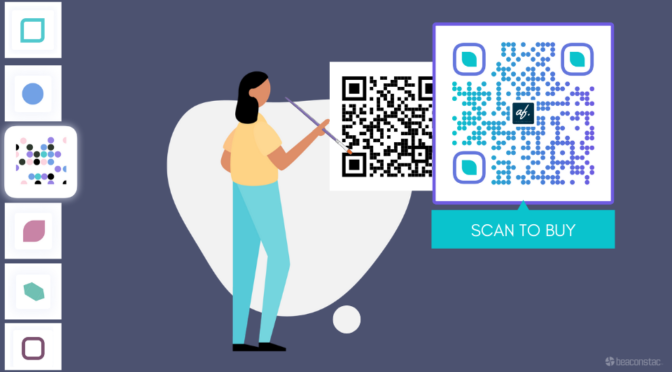Uniqode was named the #1 QR Code Generator for CBD companies by Street Fight. Get free access for 14 days!
💻 Key takeaways:
1. QR Codes on CBD packaging and labeling can display information such as the ingredients, certificate of analysis, and expiration date. They can also be used to track scans and retarget consumers.
2. Some states mandatorily require QR Codes on CBD products.
3. Dynamic QR Codes from Uniqode comply with labeling regulations and do much more, such as customization, tracking, age-gated access, and offer a layer of security over static QR Codes used in packaging.
CBD packaging regulations in 2021 and beyond
Several states in the US require that all hemp products, including CBD oils and tinctures, will be legal for purchase only when labeled. This also extends to beauty companies that create CBD-infused product lines. The label should include a QR Code that informs consumers about the ingredients used and a certificate of analysis done by a third-party lab.
So which states require a QR Code on the CBD label?
Indiana, Texas, Utah, Florida, New York, and Oregon have all made it mandatory to include a QR Code on hemp product labels. With growing CBD markets, the other States are expected to join them soon.
The BCC (Bureau of Cannabis Control) in California has made it mandatory for licensed cannabis retailers to display their QR Code certificates on storefront windows. Although this does not involve CBD labeling, it helps consumers verify the cannabis retailer’s license status upon scanning the QR Code.
Table of Contents
- CBD packaging regulations in 2021 and beyond
- Concerns with CBD products
- Adoption of QR Codes as a technology in the US
- QR Code solution build for CBD companies
- FAQs
In 2021, not all states in the U.S. require QR Codes on cannabis product labels. However, most reputable CBD companies have either switched or are switching to QR Codes on CBD labels to ensure customer delight. Not just that, adding a QR Code to a physical product unlocks a host of opportunities for the brand, which we will touch upon later in the article.
CBD product label requirements
Concerns with CBD products
- Product packaging is often inaccurate or misleading
- Products might contain other additives that alter health conditions
- Metals, pesticides, bacteria and solvents from cannabis plants might surface in products
- Concentrations of CBD are lower than advertised
- Many products for sale remain untested
- THC content might not be lower than the recommended standards of 0.3%
How to design your cannabis product label
The first step is to identify if your CBD product falls under food and beverage, or supplements. Based on this categorization, you need to follow different sets of CBD label guidelines.
If you identify yourself as a food and beverage CBD product, then refer to the FDA food labeling guide and if you are a CBD isolate (supplement) then refer to FDA labeling regulations for dietary supplements.
Based on my research and borrowing from the best in the industry, I have put together an ideal way of designing a CBD label.

How QR Codes on CBD labels help to ensure product standards & safety
QR Codes on CBD labels not only help consumers make informed decisions about the product they’re consuming but allow brands to assure quality. A cannabis QR Code on the product label can be linked to one or more of the following requirements –
- It can indicate the ingredients used and their influence on health
- the concentration of CBD being sold
- the expiration date
- the product’s certificate of analysis
Adoption of QR Codes as a technology in the United States
QR Codes are a decade-old technology that has witnessed a massive resurgence across the globe in the last couple of years. This can be attributed to two major reasons –
- Apple announced a native integration of QR scanning capabilities in the camera app. Android followed.
- Major consumer brands like Snapchat, Pinterest, Google Pay, and Amazon made QR scanning a natural phenomenon for millennials. In the United States especially, PayPal, Target, and Walmart created a similar impact.
RELATED: What marketers thought about QR Code usage in 2019
According to GlobalWebIndex, the United States, especially North America has shown significant growth in QR Code usage in the last year (2018).
QR Code solution built for CBD companies

In the context of meeting state requirements and facilitating the path to legalization, QR codes on CBD packaging and labeling play a crucial role, offering consumers easy access to essential information, including dosage guidance through tools like the Edible Dosage Calculator.
At Uniqode, we have been working with a growing number of CBD companies to do a lot more than comply with the labeling regulation.
#1. Create customized QR Codes with logo for cannabis oil packaging
Attract more scans with an attractive-looking QR Code on a CBD oil label – add brand colors, logo, and choose from our shape-shifting QR Code templates. A customized QR Code not just boosts scans, but also reinforces your branding.

#2. Deliver information dynamically with QR Codes on CBD labels
Rotate, update, or switch to temporary campaigns linked to the QR Code. With Uniqode’s dynamic QR Codes, you can reuse them for multiple campaigns without having to reprint them on CBD packaging.
Create QR Codes for PDFs for your Marketing campaigns
#3. Age-gated QR Codes for CBD labels
You can restrict your content by using our built-in feature that asks users to confirm their age and their date of birth to help you comply with local laws.
This is super easy to set up. Read our feature announcement on age-gated QR Codes to know how it works.
#4. Use a cascade of landing pages to stitch multiple pieces of information together
QR Codes can link to detailed product information, including CBD content, THC levels, ingredients, dosage recommendations, and serving sizes.
Landing pages are creative advertisement cards that you can craft on Uniqode’s editor. These cards can contain text, media, and CTAs. One idea at a time is a great way of communicating with consumers. Link them in series to deliver multiple pieces of information in one session. For example, the QR Code on your hemp product label can link to the ingredients in the package, then the certificate of analysis, and finally, a catalog of your latest products.
Similar to how you use drag and drop options on WordPress to create your websites, landing pages are great for mini websites or running specific marketing campaigns.
Related: Learn more about a QR Code landing page.

#5. Track the usage of QR Codes on CBD oil labels
Measure the campaign performance to fine-tune the positioning and size of the QR Code on the CBD oil labels. Uniqode’s QR Codes also provide a frame text with a call-to-action. Set up A/B tests with different call-to-action copies and go ahead with the best-performing one.
Check out this detailed guide on how to create a trackable QR Code to learn more.
#6. Uniqode’s QR Codes are highly secure
QR Codes can ensure compliance with legal requirements by providing access to regulatory information, such as FDA guidelines, state regulations, and industry standards.
With Uniqode’s QR solution, enjoy robust security standards and framework to deliver unlimited secure and seamless campaigns. Once your campaigns are over, you can always redirect to a default URL (your website).
Still, confused about how to choose the right QR Code generator?
#7. Retarget consumers on Facebook and Google
Reconnect with consumers on online channels even when they are not in your business location. Uniqode allows you to retarget consumers who scanned the QR Codes – on Facebook and Google. 90% of the companies have seen 3X better conversions with retargeting ads.
Frequently Asked Questions
1. What is a CBD QR Code?
A CBD QR Code is a packaging label where QR Codes are placed on CBD products to display the contents of the product. A CBD QR Code shows the amount of THC oil present in the product, missing cannabinoids, and if the product is lab-tested for authenticity.
To learn about the product ingredients, simply scan the QR Code on the CBD product and click on the link.
2. Are QR Code requirements a future for CBD products?
Yes. CBD QR Codes are imperative to learn about the product and its ingredients. In fact, states like Utah, Indiana, and Oregon have made it compulsory to include CBD QR Codes on all products containing THC.
3. Do you need a license to sell CBD oil in Indiana?
Yes. In addition to the license, merchants must also include QR Codes on all their CBD oil labels to avoid facing stiff penalties.
4. What should you include in your CBD QR Codes?
A CBD QR Code should contain the following items –
- Amount of active CBD per serving
- Supplement Fact Panel, including other ingredients present in the product
- Net weight
- Manufacturer/distributor name
- Suggested use
- Full-spectrum, broad-spectrum, or isolate
- Batch or data code
5. How does the FDA regulate CBD products and labeling?
The FDA has a set of 26 common questions and answers that allows the regulation of CBD products and labeling. In inclusion to that, the FDA regulates by keeping the following items in check –
- Not to be false or misleading
- Provide the required information (identity statement, statement of the quantity of the contents, distributor name, materials, and warning labels)
- Display information correctly
- Not violate the Poison Prevention Packaging Act of 1970
Shashank is a content marketer at Uniqode who turned to writing to pursue his natural calling after 2+ years of working in the product team. He aims to educate folks on the brilliant yet underrated technology of QR Codes. With more than a dozen Tofu and Mofu pieces under his belt, he explores how QR Codes can be used to solve challenges for businesses across all verticals. While he’s not educating users on the benefits of QR Codes, he’s also a student of the evolving marketing landscape.











